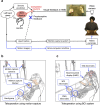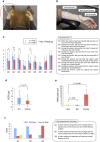Removal of proprioception by BCI raises a stronger body ownership illusion in control of a humanlike robot
- PMID: 27654174
- PMCID: PMC5031977
- DOI: 10.1038/srep33514
Removal of proprioception by BCI raises a stronger body ownership illusion in control of a humanlike robot
Abstract
Body ownership illusions provide evidence that our sense of self is not coherent and can be extended to non-body objects. Studying about these illusions gives us practical tools to understand the brain mechanisms that underlie body recognition and the experience of self. We previously introduced an illusion of body ownership transfer (BOT) for operators of a very humanlike robot. This sensation of owning the robot's body was confirmed when operators controlled the robot either by performing the desired motion with their body (motion-control) or by employing a brain-computer interface (BCI) that translated motor imagery commands to robot movement (BCI-control). The interesting observation during BCI-control was that the illusion could be induced even with a noticeable delay in the BCI system. Temporal discrepancy has always shown critical weakening effects on body ownership illusions. However the delay-robustness of BOT during BCI-control raised a question about the interaction between the proprioceptive inputs and delayed visual feedback in agency-driven illusions. In this work, we compared the intensity of BOT illusion for operators in two conditions; motion-control and BCI-control. Our results revealed a significantly stronger BOT illusion for the case of BCI-control. This finding highlights BCI's potential in inducing stronger agency-driven illusions by building a direct communication between the brain and controlled body, and therefore removing awareness from the subject's own body.
Figures


Similar articles
-
Humanlike robot hands controlled by brain activity arouse illusion of ownership in operators.Sci Rep. 2013;3:2396. doi: 10.1038/srep02396. Sci Rep. 2013. PMID: 23928891 Free PMC article.
-
'Robot' Hand Illusion under Delayed Visual Feedback: Relationship between the Senses of Ownership and Agency.PLoS One. 2016 Jul 25;11(7):e0159619. doi: 10.1371/journal.pone.0159619. eCollection 2016. PLoS One. 2016. PMID: 27454579 Free PMC article.
-
Effect of biased feedback on motor imagery learning in BCI-teleoperation system.Front Syst Neurosci. 2014 Apr 9;8:52. doi: 10.3389/fnsys.2014.00052. eCollection 2014. Front Syst Neurosci. 2014. PMID: 24782721 Free PMC article.
-
Quantification of body ownership awareness induced by the visual movement illusion of the lower limbs: a study of electroencephalogram and surface electromyography.Med Biol Eng Comput. 2023 May;61(5):951-965. doi: 10.1007/s11517-022-02744-4. Epub 2023 Jan 20. Med Biol Eng Comput. 2023. PMID: 36662378 Review.
-
Bodily ownership and self-location: components of bodily self-consciousness.Conscious Cogn. 2013 Dec;22(4):1239-52. doi: 10.1016/j.concog.2013.08.013. Epub 2013 Sep 13. Conscious Cogn. 2013. PMID: 24025475 Review.
Cited by
-
Data-driven body-machine interface for the accurate control of drones.Proc Natl Acad Sci U S A. 2018 Jul 31;115(31):7913-7918. doi: 10.1073/pnas.1718648115. Epub 2018 Jul 16. Proc Natl Acad Sci U S A. 2018. PMID: 30012599 Free PMC article.
-
"Mine Works Better": Examining the Influence of Embodiment in Virtual Reality on the Sense of Agency During a Binary Motor Imagery Task With a Brain-Computer Interface.Front Psychol. 2021 Dec 24;12:806424. doi: 10.3389/fpsyg.2021.806424. eCollection 2021. Front Psychol. 2021. PMID: 35002899 Free PMC article.
-
Embodiment into a robot increases its acceptability.Sci Rep. 2019 Jul 12;9(1):10083. doi: 10.1038/s41598-019-46528-7. Sci Rep. 2019. PMID: 31300689 Free PMC article.
-
Embodiment of a virtual prosthesis through training using an EMG-based human-machine interface: Case series.Front Hum Neurosci. 2022 Aug 4;16:870103. doi: 10.3389/fnhum.2022.870103. eCollection 2022. Front Hum Neurosci. 2022. PMID: 35992955 Free PMC article.
-
Progressive Training for Motor Imagery Brain-Computer Interfaces Using Gamification and Virtual Reality Embodiment.Front Hum Neurosci. 2019 Sep 26;13:329. doi: 10.3389/fnhum.2019.00329. eCollection 2019. Front Hum Neurosci. 2019. PMID: 31616269 Free PMC article.
References
-
- Botvinick M. & Cohen J. Rubber hands ‘feel’ touch that eyes see. Nature 391(6669), 756–756 (1998). - PubMed
-
- Pavani F., Spence C. & Driver J. Visual capture of touch: Out-of-the-body experiences with rubber gloves. Psychol. Sci. 11(5), 353–359 (2000). - PubMed
-
- Ehrsson H. H., Spence C. & Passingham R. E. That’s my hand! Activity in premotor cortex reflects feeling of ownership of a limb. Science 305, 875–877 (2004). - PubMed
-
- Tsakiris M. & Haggard P. The rubber hand illusion revisited: visuotactile integration and self-attribution. J. Exp. Psychol. Hum. Percept. Perform. 31, 80–91 (2005). - PubMed
LinkOut - more resources
Full Text Sources
Other Literature Sources

